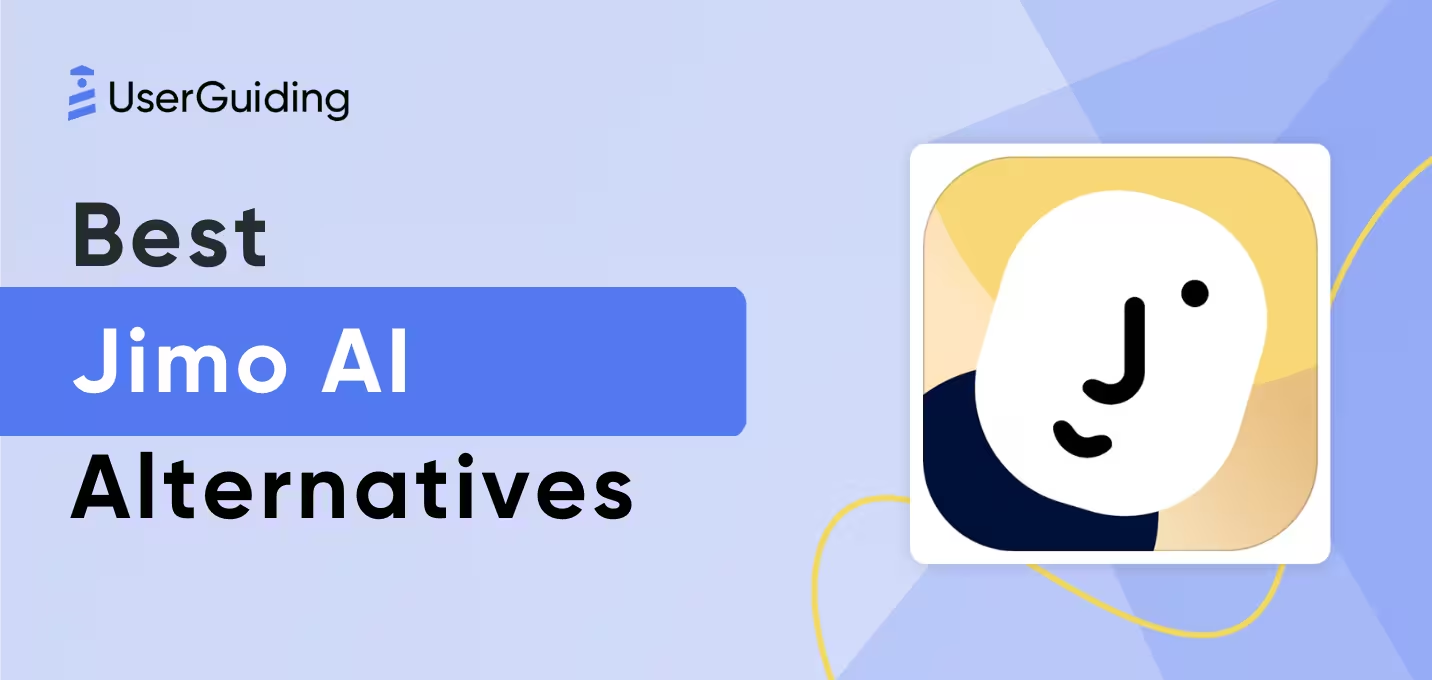

"User onboarding is what makes your product shine!’"
"Don’t think of success if you don’t onboard your employees correctly!"
"How on earth are you going to earn money without properly onboarding your customers?"
Everyone says that you should focus on onboarding and they even tell you how you should do it.
But what on earth is even this "onboarding", right?
Let’s take a deep look into what onboarding is and what the different types of onboarding are:
What exactly is Onboarding?
Here at UserGuiding, we like to think of onboarding as user education, in the broadest of senses.
But onboarding commonly refers to the process in which employees transition to a new role where they are given the resources to perform the best way possible, as well as in touch with people that play a role in a smooth transition.
Despite this, onboarding can refer to other practices, such as user onboarding, customer onboarding, merchant onboarding, client onboarding, and, of course, employee onboarding.
So, it can be said that it is limiting to refer to employee onboarding as just onboarding, which is a term that can be defined instead as the process where people are led to success or value with a product, service, or process.

So, if we are clear that onboarding isn't just employee onboarding, let's head on to another discussion ⬇️
When I say "user onboarding", what do you think of?
I'll bet it is either a product tour or an app tutorial you get when playing a whack mobile game.
And that does not do user onboarding justice.
Onboarding and especially user onboarding do include product tours, walkthroughs, and even the whacky tutorials.
But there is more to it.
The hiring/signup process is a part of onboarding; adopting the new features is a part of onboarding, basically, anything that’s done before fully adopting the product/company is a part of onboarding.
And then, yet another question...
What is the purpose of "onboarding" someone?
Even though they have different aims, all types of onboarding focus on one main thing:
- Getting people from point A to the designated point where they will know they’re in the right place.
92% of people switch companies after 3 or fewer bad experiences with them, 26% of which don’t even give a second chance. The same research also shows that people are willing to pay more to get a better service.
Onboarding someone drastically decreases the chances of them not liking your product. You simply eliminate the wrong routes by guiding them and letting them digest your service slowly.
But how do you do that?
Let’s see:
What does a good onboarding look like?
Let’s take a look at the most important 5 elements that are certain facts for every kind of onboarding:
#1 - It’s easy to get started
Study shows that a good signup form is more effective than many think.
A signup form that consists of 4 quick questions led to 120% more conversion than another with a whole page of questions.
Since the signup form is the first thing that your users/customers/clients see after deciding to use your services, it will remain as the first impression in their minds.
#2 - The introductory tour is clear and definitive
A product tour, regardless if it’s a video, a few slides, or an interactive tour, is essential to be able to onboard people.
Think of it as moving into a new house. Would you buy/rent a house without knowing what’s inside?

The manager giving a new employee an office tour and an interactive guide showing you how to use the product is equally important.
So don’t ever skip providing a product tour.
#3 - The communication channels are clear
If you were in the same office with your manager, employee, customer, provider, basically anyone that you might need to talk to at some point, you would want to know where they’re at at the moment to go and talk to them.
Otherwise, you would get distracted and maybe even feel disrespected.
The same goes for online businesses. If you are remotely onboarding someone, you would want to make sure you tell them how to contact you if they needed to talk.
If you have a live chat option, show it in the product tour.
If you prefer emails, let them know via email that they can reach out anytime.
#4 - The tasks are clear and organized
- If you want to go hiking on a route, you make a map to be on time and not to get lost.
- If you want to study effectively, you make a schedule so that you can stay on track.
- If you are writing a code, you have to follow a certain structure for the code to work.
If you are getting someone to start an onboarding process, you are the one to give them the map they’ll follow. They might be free to choose which tasks to complete first but if you don’t explain the importance of this map and the tasks, they will leave, just like a kid who didn’t like the game.
#5 - You let them know that you provide further help
Not only by chatting or emailing, but people might also need help when you are not available for them. This might be because of a different timeline, working hours, or illness.
Just like shipping a manual with a product, you should provide pre-written or pre-recorded further help to the people that are onboarding.
There are several options that you can make sure that people know they can get help without talking to you. Some of those are:
- Resource centers
- Help centers
- AI chats
- Knowledge bases

Types of Different Onboardings
Employee Onboarding
Definition:
Employee Onboarding is making a new employee adopt the company, its values, and getting to the point where they are fully in sync with the role. Employee Onboarding can be done face-to-face, or virtually, and in the second key, communication becomes the most important factor to successfully Onboard an employee.
Study showed that 92% of employees reported that they felt important and creative after initial cultural and operational onboarding.
To successfully onboard employees, letting them know in detail about the process they will go through at the beginning will help them set their goals accordingly.
Example: RAM
RAM onboards both their existing employees and new hires to their IT platform with an interactive tour and resource center.
First, they are warmly welcomed by a welcome module that feels like a real person:

Then they’re asked to do an ID check to prevent any inconveniences:

Right after comes informing them how to get further helps if they need it anytime:

Noticed how everything is explained in a simple but definitive language? The same goes for the product tour:

And at the end, employees are not left alone with a blank page. They are congratulated for taking the initial onboarding tour, and the latter is shown to them in a checklist:


If you want to learn more about how to perfectly onboard employees, here is a definitive guide for you.
Customer Onboarding
Definition:
Customer Onboarding is getting the person who makes the purchase to adopt the service fully. For B2C, every user onboarding would be a customer onboarding at the same time. For B2B, the Customer Onboarding differs from end-user onboarding, and needs to be more comprehensive.
Onboarding customers to your B2B product or SaaS is a longer process than it’s actually thought.
The process begins as soon as the potential customer finds out about your product, and doesn’t end untill the end-users adopt the product.
That’s probably why they say that acquiring new customers costs higher than maintaining the existing ones.
Example:
As I said, customer onboarding starts way before the trial of the product. To provide a good onboarding experience, your resources such as your website and blog need to be well designed and definitive.
Then comes the demo or trial. During this period, you need to point out your product’s strengths and show its value to convince the customer.
For instance: ClearBrain is a data analytics platform which - obviously - needs you to share precise detail about your company, therefore their trial needs to be definitive.
ClearBrain did a pretty good job on that, even with the welcome modal:

And further explanations don’t end with only the first module, they did a pretty good job with filling the empty state of waiting for the results:

Here I leave the definitive guide for Customer Onboarding, just in case you want to have a deeper understanding of the topic.
User Onboarding
Definition:
User Onboarding, otherly referred to as End-User Onboarding or User Adoption, is the process of onboarding the people who use your product. The main goal of User Onboarding is to get the users to like the product so much that they become promoting users.
How you onboard your users might even be more important than any other thing that you provide them since people tend to leave something they didn’t like in an instant.
Let’s dig down into the elements of User Onboarding with an example:
Example:
Just like any other, the User Onboarding process begins before diving into the product. Even the signup form matters.
Here’s a good example of a good signup form:

Of course, this doesn’t mean everything else won’t matter. How you welcome your users and how much you explain to them is also crucial.

I think User Onboarding can be considered a form of art, and it’s too deep to explain and learn just with a definition.
So here I leave the most comprehensive guide on User Onboarding that you can find on the internet - you’re very welcome 😄
Client Onboarding
Definition:
Client Onboarding is simply welcoming your clients and introducing them to your services. The main goal of Client Onboarding is to find a mutual path that benefits both you and your client. Client Onboarding is the onboarding type that requires the most communication and the most personalization.
It’s a fact that no matter who you are onboarding, follow-up emails are crucial to guaranteeing successful onboarding.
The importance of emailing gets to a higher level when it comes to client onboarding. Follow-up emails, calls, even some chit-chat within every conversation play a crucial role.
This is because clients expect to be recognized by you - to be able to recognize you.
Example:
Since client onboarding is mostly made by personal conversations, it can differ from one person to another.
As long as you understand the needs and wants of the customer, and combine them with your solutions, the only thing that’s left is how you transfer it to your clients.
You can use an FAQ page or a help center to give your clients a head-start and let some weight go off your shoulders.

Also, here I leave checklists for different types of clients for you to not miss any part.
Final Words
Onboarding is much more than just the orientation or the product tour. Also, there are many different types of Onboarding, each with its own requirements and elements.
Understanding the meaning of Onboarding is the first step towards perfecting your Onboarding process, hence, increasing revenue.
Frequently Asked Questions
How long should onboarding take?
The main goal of Onboarding, which is full adoption, usually happens after 3 months. This can go up to 12 months with Employee Onboarding and it can be turned into a continuous cycle in User Onboarding.
What is another word for onboarding?
User Adoption is a common way to refer to User Onboarding. As for Employee Onboarding, people tend to call it Orientation or Induction, but Employee Onboarding is a longer process that covers both terms.
Is induction and onboarding the same?
No, Induction and Onboarding are not the same. Induction is a short process that usually happens on the first day, while Onboarding is an experience and is supposed to last for months.

















.svg)
.svg)
.svg)
.svg)
.svg)

.svg)
.svg)












.svg)
.svg)




.png)
















